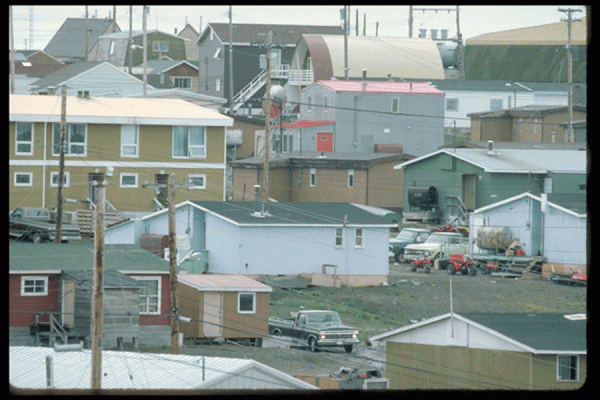Housing
The housing needs in Inuit communities are the highest amongst all populations in Canada, with 40 per cent of Inuit living in overcrowded housing compared with six per cent of Canadians as a whole. In 2011, the “core” housing need — meaning the number of people needing access to suitable housing — was 33.6 per cent for Inuit, compared with 12.5 per cent Canada-wide.
Throughout Inuit Nunangat, a deep and costly housing crisis has persisted for decades. It began in the second half of the 20th century when more Inuit began to live in permanent settlements. In some cases, Inuit were forced to relocate to other settlements by federal, provincial and territorial governments because their communities were seen as too small or too remote to provide services. Commitments were made to provide housing to Inuit settling in these communities, but the housing provided was extremely inadequate. Many spent their first few years living in the communities in tents because no housing was available when they were relocated. Communities were instantly overcrowded, and households were ill-equipped by all standards, let alone those living in Arctic and Subarctic conditions.
Inuit experience enormous stress from the negative effects of overcrowded and inadequate housing.

Inuit communities lack the numerous and diverse housing options available in southern Canada. The housing continuum for most Inuit communities is generally restricted to public housing units for the majority of Inuit, government staff housing subsidized by employers and very expensive single-family dwellings that are limited to the few communities large enough to have private housing markets.
Because housing affects every aspect of life, including work, health, education and family, it is crucial that quality housing be made available to everyone. Inuit experience enormous stress from the negative effects of overcrowded and inadequate housing. The Inuit population is the youngest population in the country, with a median age of 23. Throughout Inuit Nunangat, the chronic lack of housing stifles youth social mobility, with overcrowding linked to increased health problems for youth, who often find it difficult to get enough sleep or find a quiet place to study and do their homework. Having access to appropriate and affordable housing is critical for improving education and learning along with health and well-being.
Today, Inuit are involved in the direct management of housing in their communities. In addition to managing housing directly, each Inuit land claims organization has well-established and reliable construction divisions and economic development organizations that were created to ensure the maximum level of benefits remain in Inuit communities.
The solutions for improving housing outcomes will not look the same for all regions. Each Inuit region is unique in terms of housing delivery, roles and responsibilities (the nature of partnerships within each jurisdiction for the delivery of housing) and specific housing needs. In addition to inconsistent or non-existent access to federal housing funding, as described above, the criteria associated with federal and provincial programs generally do not result in appropriate housing solutions for Inuit communities.

Affordability is the biggest barrier to increasing private home ownership or rental options for Inuit in Inuit Nunangat. Housing construction and operation and maintenance costs in Inuit communities are extremely high. When combined with the high cost of living and the low income levels of many Inuit families, renting or owning a home, without significant subsidies, is impossible. The federal government’s national housing strategy (a 10-year, $40-billion plan announced in late 2017) and subsequent policies and programs must take into consideration how these high costs drastically and negatively impact life in Inuit communities. The government must commit to work in partnership with Inuit to find ways to reduce the costs associated with lot development, construction and operations and maintenance, including the transportation of materials. Having access to direct, flexible investments would ensure that Inuit authorities can make the most impact toward addressing the needs in their communities.
Targeted efforts in the Inuit regions are leading to improved housing designs that will hopefully begin to spread further throughout Inuit communities, helping to ensure the sustainability of housing in Inuit Nunangat. One example of an improved design is a prototype duplex constructed in Nunavik, Que., following collaboration from a number of partners. A second example is a sixplex design under construction in Nunatsiavut by the Nunatsiavut government.

Order now
from Amazon.ca or Chapters.Indigo.ca or contact your favourite bookseller or educational wholesaler




